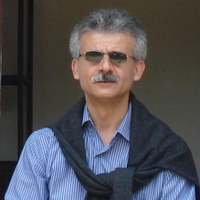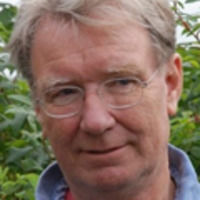Papers by Julian Henderson

iScience, Nov 30, 2023
Our understanding of glass production in Eurasia has been built mostly on evidence from Europe an... more Our understanding of glass production in Eurasia has been built mostly on evidence from Europe and the Mediterranean. Here, we investigate the occurrence and organization of plant-ash glass production in the eastern continental Islamic region, focusing on an 11th–12th century assemblage unearthed in Shadyakh, Nishapur, Iran. Through Sr-Nd isotope analysis and by examining geochemical contexts and mixing patterns, we find that distinct silica and ash sources originating from Tigris-Euphrates Basin, Central Asia, and potentially Iran were used to make these objects. Zagros-derived silica and Central-Asian-type silica were likely important silica sources for Islamic plant-ash glasses from east of the Tigris. Furthermore, we show that Central Asian glass can be characterized by chemical and isotopic signatures, while Iranian glass may exhibit overlapping signatures with glass from neighboring regions. The plant-ash glass industry in Islamic-period West and Central Asia likely thrived by exploiting and sharing diverse, regionally characteristic raw material sources.
... express prior written consent of the publishers. ISBN 978 90 5867 690 0 D/2009/1869/1 NUR: 68... more ... express prior written consent of the publishers. ISBN 978 90 5867 690 0 D/2009/1869/1 NUR: 682-971 Lay-out: Friedemann BVBA (Hasselt) Cover: JurgenLeemans Page 6. 5 Acknowledgements At the 35th 'International Symposium ...
Antiquity, Sep 1, 1988
A knowledge of pyrotechnology - the skills of creating and working with high temperatures - attes... more A knowledge of pyrotechnology - the skills of creating and working with high temperatures - attested for later prehistoric Europe first by refined ceramics in the Neolithic, then by copper and bronze metallurgy. But what about the third aspect of pyrotechnology – faience, glass and other vitreous materials? New work reported in this survey shows a place for glass in the European Bronze Age.

Glass is a fascinating material. It is delicate yet strong; colourless or brightly coloured, and ... more Glass is a fascinating material. It is delicate yet strong; colourless or brightly coloured, and on a par with precious stones. It sounds when struck, it does not smell or tarnish, and it does not adulterate the taste of food and drink. It is beautiful, and a hot topic in contemporary research, with our knowledge about glass making, working and use rapidly expanding. Much new information is emerging from fieldwork, case studies, and innovative trace element and isotopic analyses; time for a textbook. Julian Henderson is an established scholar with a long history of glass research. His recent book is, with over four hundred pages, substantial enough for this important and complex topic. Four introductory chapters tackling the material and chemical properties of glass lay the foundation for subsequent chapters that explore the archaeology and science, respectively, of 'Early Glass in the Middle East and Europe' (Chapters 5 and 6), 'Hellenistic to Early Roman Glass' (Chapters 7 and 8), and 'Islamic Glass' (Chapters 9 and 10). The final chapter is devoted to 'Provenance of Ancient Glass', and with nearly sixty pages, takes a considerable part of the whole.

Levant, 1999
Archaeological excavations of an Islamic industrial complex in northern Syria at al-Raqqa have re... more Archaeological excavations of an Islamic industrial complex in northern Syria at al-Raqqa have revealed comprehensive evidence for Abbasid high temperature industries. Amongst the evidence is some for glass production. The evidence included a glass workshop consisting of the remains of three-chambered 'bee-hive' furnaces and a centralised flue system, the debris of casting glass into blocks of three different sizes, glass moils of two diameters (the knock-offs from blowing irons) and discarded lumps of frit, a material produced by the initial stage in glass production. In addition, fragments of a second kind of glass furnace, a tank furnace, were found. Scientific analysis of the products and by-products of this glass industry using electron probe microanalysis has produced an unexpectedly wide range of glass chemical compositions. In some instances discrete compositions are correlated to the function of the glass such as its use to make cast blocks and window panes. In others instances, such as when it is used to make glass vessels, the same apparent degree of specialisation in the deliberate selection of particular glass raw materials is not evident. Scientific analysis of frit has shown that the glass used to make the windows for glazing the al-Raqqa palace complexes was made in al-Raqqa.
MRS Proceedings, 1988
This paper deals with a unique glass bead of probable second millennium BC date from Wilsford, Wi... more This paper deals with a unique glass bead of probable second millennium BC date from Wilsford, Wiltshire in southern England. The date of the bead is probably Wessex II; c. 1400 – 1200 BC. It was first recognised as being glass [1] in print in 1812, but until recently [2] has been considered as being of stone rather than glass in line with its original description. Here the bead is described together with surface SEM studies, the replication work on glass of similar composition reported and its unusual chemical composition discussed in terms of its durability and comparable Bronze Age glass compositions. This paper is partly the result of a collaborative project involving the author, Margaret Guido, Michael Cable, Justine Bayley and Leo Biek.
MRS Proceedings, 1990
Chemical characterization of Roman glass vessels, enamels and tesserae has revealed compositional... more Chemical characterization of Roman glass vessels, enamels and tesserae has revealed compositional relationships between enamels and tesserae including the use of high magnesia red and orange glass, normally considered to have gone out of use hundreds of years earlier. The conservative use of glass recipes over a 300 year period is reflected in the compositions; the results of mass-production versus more restricted production are discussed.
Studies in Conservation, Feb 1, 1992
Includes a complete chemical examination of the causes of the deterioration of glass, discusses t... more Includes a complete chemical examination of the causes of the deterioration of glass, discusses the possibilities of damage by conservation techniques that have not been fully tested, and provides the theoretical background and the practical procedures used in conserving different kinds of glass. Contents: introduction; the nature of glass; historical development of glass; technology of glass production: methods and materials; furnaces and melting techniques; deterioration of glass; materials used for glass conservation; technical examination of glass; conservation of glass; archaeological and decorative glass, painted window glass; sources of information. -- AATA
Antiquity, Mar 1, 1992
Dunmisk fort (Co. Tyrone), in Northern Ireland, has produced the first evidence recognized in ear... more Dunmisk fort (Co. Tyrone), in Northern Ireland, has produced the first evidence recognized in early medieval Europe for the makinglmodification of glass using primary raw materials. Going beyond the evidence for glass-workingthe softening of glass to form and decorate artefactsa series of sophisticated industrial processes can be identified, and shows that not all glass was imported to Early Christian Ireland.
Proceedings of the Prehistoric Society, 1982
Analyses of recent finds of ‘coin moulds’ from Levroux (Indre) and Aulnat (Puy-de-Dôme), France, ... more Analyses of recent finds of ‘coin moulds’ from Levroux (Indre) and Aulnat (Puy-de-Dôme), France, confirm that these objects were used for casting globules of gold and silver. Though quantitatively the majority of recorded finds come from defended oppida, more than half the sites to produce ‘coin moulds’ are open settlements, suggesting coin production was not centralised, at least in the second century BC.

iScience, 2023
Our understanding of glass production in Eurasia has been built mostly on evidence from Europe an... more Our understanding of glass production in Eurasia has been built mostly on evidence from Europe and the Mediterranean. Here, we investigate the occurrence and organization of plant-ash glass production in the eastern continental Islamic region, focusing on an 11th–12th century assemblage unearthed in Shadyakh, Nishapur, Iran. Through Sr-Nd isotope analysis and by examining geochemical contexts and mixing patterns, we find that distinct silica and ash sources originating from Tigris-Euphrates Basin, Central Asia, and potentially Iran were used to make these objects. Zagros-derived silica and Central-Asian-type silica were likely important silica sources for Islamic plant-ash glasses from east of the Tigris. Furthermore, we show that Central Asian glass can be characterized by chemical and isotopic signatures, while Iranian glass may exhibit overlapping signatures with glass from neighboring regions. The plant-ash glass industry in Islamic-period West and Central Asia likely thrived by exploiting and sharing diverse, regionally characteristic raw material sources.

In Stoepker, H. (ed.), Sporen van Susteren, archeologische vondsten uit een Karolingisch klooster en een adellijk vrouwenstift, de basispublicatie, Venlo, 1357-1382. , 2023
Introduction glass technology Roman glass was mass-produced mainly in massive rectangular tank fu... more Introduction glass technology Roman glass was mass-produced mainly in massive rectangular tank furnaces on the Levantine coast from sand and a mineral source of soda, natron, hence the term 'natron glass'. This continued into the Byzantine era for which most evidence dates to the 6th-8th centuries AD. 1 From around 800 AD the Muslims made glass by combining sand and ashes of shrubby plants that grew in semi-desert environments in the Middle East. They also constructed large tank furnaces and other furnaces, including a probable down-draught furnace at al-Raqqa, to melt glass in 2 ; the Muslims were partly responsible for this 'transition' in glass technology from natron to plant ash glass. In inland locations plant ash was far more accessible as a source of flux than the considerably more restricted sources of the mineral natron which mainly derived from a likely primary source, the Wadi el Natrun in Egypt, and it is this natron which was used by the Romans. 3 The Middle Eastern Sasanians were already making plant ash glass between the 3rd and 7th centuries. 4 Simpson 5 discusses the unexcavated evidence for glass production mainly found at Veh Ardašīr in central Iraq. There is a lot of surface evidence for production which may well include evidence for primary glass making. Radiogenic isotopic analysis of Sasanian glass 6 supports the evidence for the use of more than one source of sand provided by trace element compositions for glass found at Veh Ardašīr published by Mirti et al. 7 The isotope results are also suggestive of a distinctive 'Sasanian' signature. When compared with early Islamic glass from Ctesiphon-Islamic al-Madā'in (essentially the same location
iScince, 2023
Sr-Nd isotopes help characterize diverse plantash glasses from eastern Silk Roads Decentralized p... more Sr-Nd isotopes help characterize diverse plantash glasses from eastern Silk Roads Decentralized production likely used diverse raw materials within regional networks Trade brought glass from Iraq, Syria, Central Asia, and potentially Iran to Shadyakh Regional signatures distinguish between Zagros-derived and Central-Asian-type silicas

Proceedings of SPIE, Nov 7, 2012
ABSTRACT This paper presents recent work done on the application of Time of Flight Secondary Ion ... more ABSTRACT This paper presents recent work done on the application of Time of Flight Secondary Ion Mass Spectrometry (ToFSIMS), a high lateral resolution surface analysis technique, to the study of opacifying inclusions in ancient and historical glasses. A small selection of ancient glass samples have thus far been analyzed by this technique with great success. The combination of surface sensitivity and high lateral resolution offered by the technique is uniquely placed to address the detailed chemical composition of the opacifying inclusions themselves, without interference from the surrounding glass matrix. The research team seeks to further develop the use of ToF-SIMS for addressing issues of provenance and understanding the technological processes involved in adding opacifying inclusions to ancient glass, through further analysis of relevant material and through the production and analysis of replica opaque glasses. The technique itself will be discussed along with some of the preliminary results obtained and proposals for future work in this field.
Cambridge University Press eBooks, Feb 5, 2013
Cambridge University Press eBooks, Feb 11, 2013
Levant, 1998
This article is a preliminary report on an assemblage of pottery found at al-Raqqa in the course ... more This article is a preliminary report on an assemblage of pottery found at al-Raqqa in the course of excavations earned out in 1995 as part of The Raqqa Ancient Industry Project. The assemblage was excavated from a pottery production area located in the modern suburb of Mishlab,. it ...
Archaeometry, Mar 1, 2009











Uploads
Papers by Julian Henderson